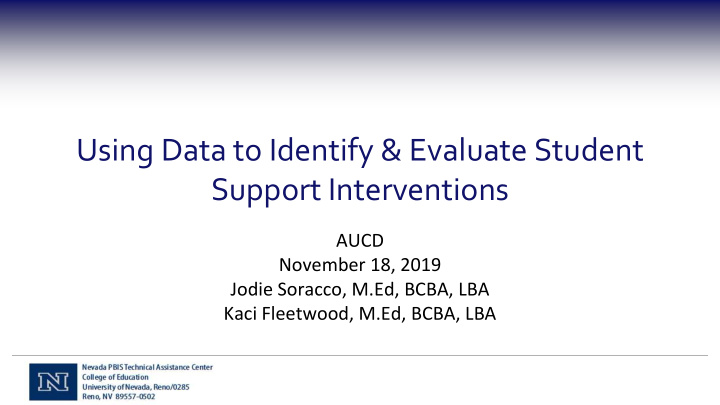



Using Data to Identify & Evaluate Student Support Interventions AUCD November 18, 2019 Jodie Soracco, M.Ed, BCBA, LBA Kaci Fleetwood, M.Ed, BCBA, LBA
USING ADVANCED TIER DATA
The Process Implement Assess Evaluate
4
From General to Precise _______________________________ Who _______________________________ _______________________________ What _______________________________ Data can be ____________________________ analyzed to ____________________________ When identify answers ______________________ to these critical ______________________ Where questions ________________ Why ________________
6
Tier 2 # of Students in Tier II Identifiers (%) Tier 1 Proportion (%) Intervention Intervention Intervention Success Rate (%) 24 Ethnicity Ethnicity CICO African American: 42% African American: 36% American Indian: 4% American Indian: 3% Asian: 0% Asian: 3% Latino: 25% Latino: 23% Multiracial: 0% Multiracial: 4% Pacific Islander: 0% Pacific Islander: 2% White: 25% White: 29% Other: Other: Gender Gender Male Male Female Female 75% 55% 25% 45% Disability Disability Status Status (IEP) (IEP) Yes Yes No No 29% 20% 80% 71% 8
Tier 1 Proportion to Tier 2 Identifiers 80% 75% 70% 60% 55% 50% 45% 42% Tier 1 population 40% 36% Tier 2 Identifiiers 29% 29% 30% 25% 25% 25% 23% 20% 20% 10% 4% 4% 4% 3% 3% 2% 0% 0% 0% African American American Indian Asian Latino Multiracial Pacific Islander White Male Female IEP Status 9
From General to Precise Over: African American, Males, IEP Who Under: White, female Tier 2 What How students are identified When CICO Where Why Systems Issue
Problem Analysis • Why is it happening? –Systems may not be culturally responsive –Explicit or Implicit Bias • Disproportionality across all settings indicates explicit bias • Disproportionality in specific settings indicates implicit bias 11
The Process Implement Assess Evaluate
Who Gets Access To Advanced Tier Supports? • Currently how are students referred or identified to advanced tier interventions?
1.Systems DDR 14
SBAC ISS/OSS Counselor Visits Nurse Referrals/Visits GPA Data! Truancy Citations Parent Contacts Citizenship Grades MAPS Attendance ODRs Safe School Professional Nominations Testing Universal Screening Teacher Nominations Scores 15
Set Floors and Ceilings with Data • Determine what the threshold is for students who need tier 2 support • ALSO determine the cap for students who need more intensive supports 16
Triangulate Data Triangulate data for students at moderate and high risk 5 th Grade Moderate ODRS Attendance Academic Students Score (E/I) (M/m) Concerns Kaci I (3) 1 M 2 m 80% Low Jodie E (11) & I 0 75% Significant (4) Kathryn I (2) 1 m 98% Moderate 17
A Future Goal 18
All Together Now… Identify Triangulate Identify Identify Select Tier Data Data Students Need Practices Sources Develop Practice DDRs 19 19
2. Advanced Tiers Practice DDR 20
Data Decision Rules (DDR) Having predetermined criteria for: • How students get access to, and… • How students graduate out of interventions 21
Example Data Decision Rules Support/ Description Entry Criteria Data to Progress Exit Criteria Monitor Interventions Small group Small group SRSS-IE: E7 or I5= ODRs earned for SRSS-IE low risk instruction by Moderate or High social/peer social skills counselor or other Risk challenges ODRs earned=0 instruction: trained Skills AND interventionist. Scores on Weekly Improvement on Streaming Office Discipline Progress Report report card social Curriculum Lessons taught Referrals (ODR): indicators based on identified 2+ for social/peer Attendance in needs in student challenges group Mastery of group. 20 min, 4x lessons related to AND per week. target skill(s) in “Needs “Internalizers” group group separate from Improvement” on “externalizers” group Report Card social indicators 22
Example DDR 23
The Process Implement Assess Evaluate
1) How well did it meet the need? 2) For whom was it most effective? 25
Tier 1 Proportion to Tier 2 Identifiers 80% 75% 70% 60% 55% 50% 45% 42% Tier 1 population 40% 36% Tier 2 Identifiiers 29% 29% 30% 25% 25% 25% 23% 20% 20% 10% 4% 4% 4% 3% 3% 2% 0% 0% 0% African American American Indian Asian Latino Multiracial Pacific Islander White Male Female IEP Status 26
Questions To Consider During Evaluation
In Summary • We want to hear from you! -Questions Comments Feedback
Recommend
More recommend